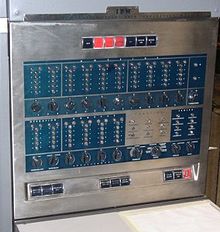
Back حاسوب عشري Arabic Dezimalrechner German Ordenador decimal Spanish Десятичный компьютер Russian Десятковий комп'ютер Ukrainian

A decimal computer is a computer that can represent numbers and addresses in decimal and that provides instructions to operate on those numbers and addresses directly in decimal, without conversion to a pure binary representation. Some also had a variable wordlength, which enabled operations on numbers with a large number of digits.
Decimal computers were common from the early machines through the 1960s and into the 1970s. Using decimal directly saved the need to convert from decimal to binary for input and output and offered a significant speed improvement over binary machines that performed these conversions using subroutines. This allowed otherwise low-end machines to offer practical performance for roles like accounting and bookkeeping, and many low and mid-range systems of the era were decimal based.
The IBM System/360 line of binary computers, announced in 1964, included instructions that perform decimal arithmetic; other lines of binary computers with decimal arithmetic instructions followed. During the 1970s, microprocessors with instructions supporting decimal arithmetic became common in electronic calculators, cash registers and similar roles, especially in the 8-bit era.
The rapid improvements in general performance of binary machines eroded the value of decimal operations. One of the last major new designs to support it was the Motorola 68000, which shipped in 1980. More recently, IBM added decimal support to their POWER6 designs to allow them to directly support programs written for 1960s platforms like the System/360. With that exception, most modern designs have little or no decimal support.